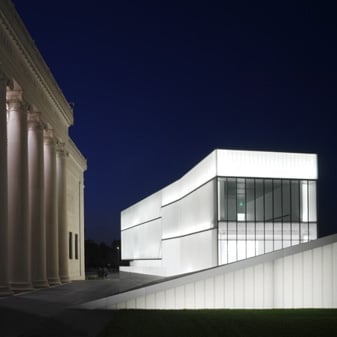
Nelson-Atkins Museum of Art by Steven Holl
Here is a set of new images of the extension to the Nelson-Atkins Museum of Art in Kansas City by architect Steven Holl.
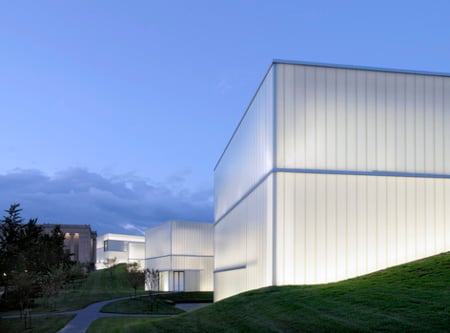
The Bloch Building, which opens in June, adds five new pavilions to the existing neo-classical building.
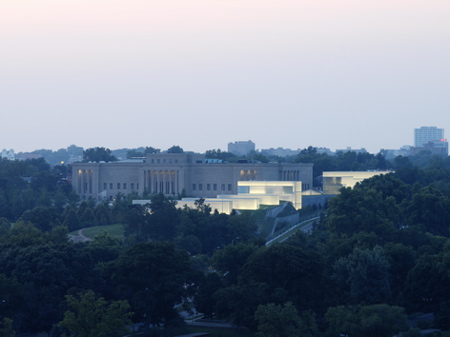
Photos are by Andy Ryan.
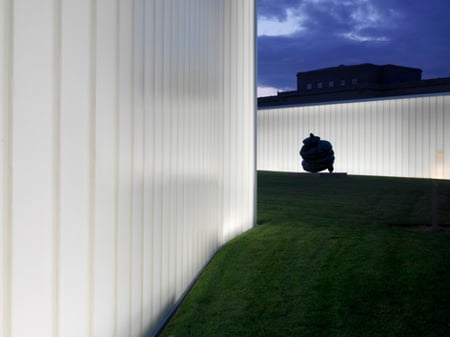
Update: a comprehensive press release about the extension follows after the photos.
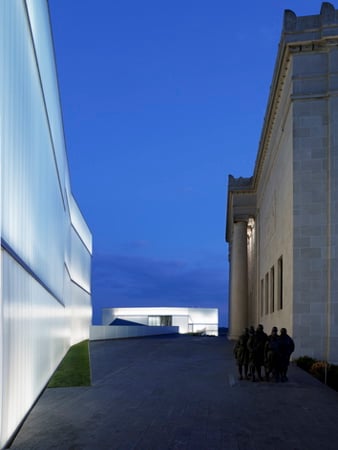
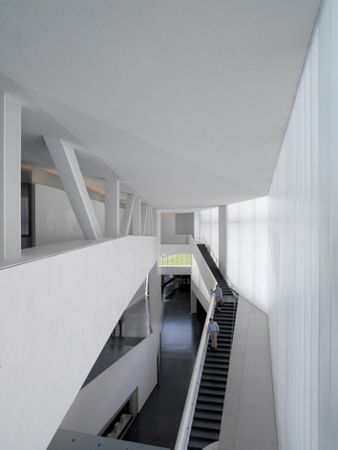
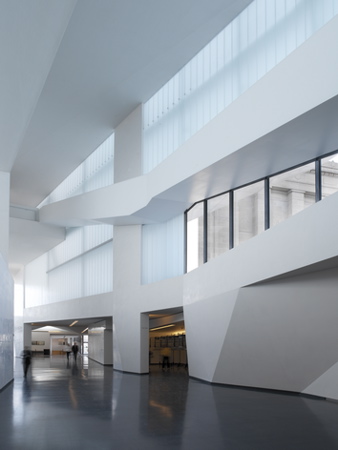
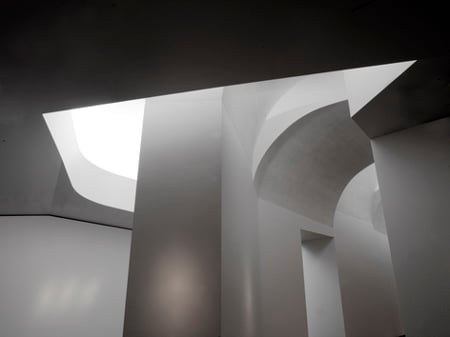
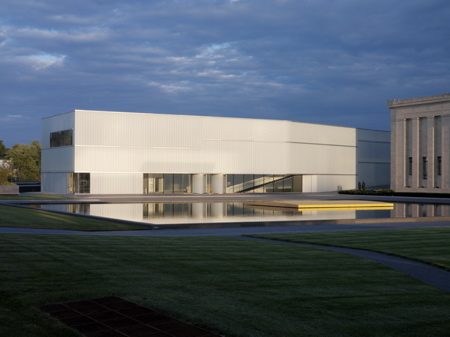
Press release follows:
--
The Nelson-Atkins Museum of Art to Open Bloch Building on June 9
Steven Holl’s Bloch Building Culminates an Institution-Wide Transformation Integrating Architecture, Landscape, and Art to Create a Dynamic Museum Experience
Opening Exhibitions Highlight Masterworks of Impressionism from Never-Before-Seen Bloch Collection, Groundbreaking Early Photography from Recently Acquired Hallmark Collection, and Rare Kiki Smith Installation
Kansas City, Mo., April 2, 2007 – The remarkable new Bloch Building – the much-anticipated expansion of The Nelson-Atkins Museum of Art – will open to the public on Saturday, June 9. The new building was designed by renowned architect Steven Holl, who offered the plan as a daring solution to the Nelson-Atkins’ need for more space.
The slender, elongated building runs along the Eastern edge of the campus and provides a delicate counterpoint to the original 1933 Beaux-Arts building. Five lenses constructed of twin layers of glass walls emerge from the ground and create a luminous, undulating interplay between architecture and landscape.
Prior to the public opening, the Museum will open its doors to local, national and international media at a Press Preview on June 1. Events will include building previews, gallery and exhibition tours, and remarks by project leadership including Museum Director Marc F. Wilson, Architects Steven Holl and Chris McVoy, and other members of the curatorial and architectural teams.
The Bloch Building is the centerpiece of a dramatic transformation of the entire institution that includes major renovations to the original building, a restoration of the Kansas City Sculpture Park, and a complete reinstallation of the permanent galleries, drawing from the more than 34,500 works in its encyclopedic collection.
The new 165,000-square-foot expansion increases Museum space by more than 70 percent and features five distinct levels of expansive, light-filled galleries. Visitors will find a new main lobby, Museum Store, Museum Café, and Spencer Art Reference Library. The project has received strong support from the community, with more than $200 million raised for the renovation and expansion and $170 million raised to grow the endowment fund.
“The completion of this amazing transformation is an aesthetic and programmatic achievement, both for the Nelson-Atkins and for the entire community of Kansas City, which has supported us enormously through this process," said Marc F. Wilson, Menefee D. and Mary Louise Blackwell Director/CEO of the Museum. “With a world-class building, never-before-seen works in our special exhibitions, and rejuvenated permanent collection galleries, we can’t wait to welcome visitors from all over to experience the new Nelson-Atkins Museum of Art."
The new Bloch Building is part of a bold strategic plan to greatly increase the Museum’s role in the community and region, with continues the Museum’s commitment to keep admission free every day for all visitors. The overall vision includes expanded programming, an increase in studio classrooms and educational resources, and a strengthened endowment that supports these initiatives.
The Nelson-Atkins’ expansion is also leading a field of new investments in local cultural infrastructure that, along with major downtown and regional revitalization efforts, is known as Kansas City’s “$6 Billion Renaissance." Large-scale civic and private projects currently underway include: Kansas City Live!, a downtown entertainment district; a new corporate headquarters for H&R Block; and the Sprint Center Arena, a 20,000-seat facility housing the National Collegiate Hall of Fame.
In addition, the Kauffman Center for the Performing Arts Center, designed by architect Moshe Safdie and now under construction, will bring the Kansas City Symphony, the Kansas City Ballet, and other performing arts organizations under one roof and create a hub for live performance in the city.
Selected through an international juried competition, Steven Holl Architects was awarded the commission for the new building in 1999. The proposed design for the Museum was an imaginative and unexpected solution to the institution’s needs, balancing innovation with respect for the beloved Nelson-Atkins Building.
In their proposal, Steven Holl Architects connected the original and new buildings and offered a line of galleries and public spaces interlaced with the landscape, opening, rising and descending along the eastern edge of the Sculpture Park lawn. Their design became the clear choice for its architectural achievement as well as its physical expression of the Nelson-Atkins’ mission and philosophy.
The Bloch Building Design Overview
The centerpiece of the campus transformation is the new Bloch Building, named in honor of Henry W. Bloch, co-founder of H&R Block and chairman of the Nelson-Atkins’ Board of Trustees, and his wife Marion. The extension connects to the eastern end of the 1933 building and runs 840 feet along the edge of the Museum’s Sculpture Park.
While respecting the earlier architecture and the community’s wishes to retain the integrity of the iconic silhouette, the Bloch Building’s subdued architectural statement remains innovative and adds a strikingly contemporary note to the Museum campus.
The five lenses, actually twin layers of glass walls, emerge from the ground and create a dynamic interaction between architecture and landscape, inside and outside, translucence and opacity, tranquility and energy. The scheme creates unique spaces for particular works of art, with a court dedicated to the Museum’s significant holdings of Isamu Noguchi sculptures and an entry plaza and reflecting pool designed by Holl to contain a specially commissioned piece by installation artist Walter De Maria.
At the northernmost end of the campus, the translucent upper section of the Bloch Building will house the new main lobby for the Museum, as well as public spaces such as the Café, Spencer Art Library and Museum Store, and office and support spaces for the staff. Visitors may enter from a new underground parking facility, through a connecting gallery in the Nelson-Atkins Building, or from an elegant entry plaza, bordered by the Nelson-Atkins on one side and the Bloch building on the other. Featuring De Maria’s elegant One Sun /34 Moons, a site-specific work within a reflecting pool, the plaza unites the two buildings as their silhouettes are reflected in the surface of the shallow water.
From the lobby, visitors will descend through five distinct levels of galleries that invite a lively interaction between art and architecture. A main artery along the western edge of the building allows visitors to choose a straight path toward the building’s southern end, entering individual galleries at various points along the way. Alternatively, visitors can enter the first gallery from the lobby and continue to move southward on a sinuous, flowing path of stairs and ramps from one gallery to the next.
The galleries drop in harmony with the slope of the 22-acre Sculpture Park. Conversely, as each gallery level steps down, the ceiling of that level peaks with a glass-enclosed lens that rises above ground level. By day, sunlight is reflected into galleries below. At night, gallery lights glow softly through the mix of translucent and transparent glass panels, like Japanese lanterns illuminating the Sculpture Park.
Internally, the lenses create vaulted ceilings and cathedral-like spaces. Externally, they ascend out of the ground as sculptural interventions, playing with the landscape and engaging visitors both inside and out to partake in the architectural experience. In between these glass lenses, a layer of grass creates a green roof where visitors can admire sculptures or relax with a picnic. This integration of landscape and architecture creates a building that is neither above nor below ground, but both at the same time.
Near the south end of the Bloch Building, visitors can look out clear glass façades for punctuated views across the wooded campus. The Isamu Noguchi Sculpture Court features an elegant installation of the Museum’s collection of large-scale masterworks by the sculptor, second only to the Noguchi Museum in Queens, New York. In the Noguchi Court, the separation between art inside the Bloch Building and art in the outdoor Sculpture Park is dissolved visually, emphasizing the relationship to nature that inspired Noguchi’s work. One of his pieces, Fountain (1987), has been installed to straddle the clear glass exterior wall and emerges on either side to exist in both the gallery space and as part of the Sculpture Park collection.
The Nelson-Atkins Building Renovation and Collections Reinstallation
Renovations to the 73-year-old Nelson-Atkins Building, designed and overseen by project architects Berkebile Nelson Immenschuh McDowell of Kansas City, are also a major component of the campus transformation. Those efforts include: the refurbishment of Kirkwood Hall and the 500-seat Atkins Auditorium; cleaning and conservation of the Nelson-Atkins’ stone façade; replication and refurbishment of Beaux-Arts detail work throughout the building; new elevators for transporting both visitors and art; and upgrades to the infrastructure and roof.
Another important component of the project was the addition of the Ford Learning Center, which opened in September 2005 and is now the Museum’s expanded home for its renowned education and outreach activities. Located on the Museum’s ground floor and only steps away from the galleries, this model arts education program begins with firsthand looking, discussing, and experiencing works of art in the Museum’s collection and triples the area dedicated to education.
Additional gallery space has allowed the Museum to intensively reexamine its artistic holdings. This process has led to a transformation in the presentation and interpretation of the entire Nelson-Atkins collection that is both physical and intellectual. Taking a multidisciplinary approach, curators collaborated with the architectural team, designers, and the education staff to encourage new thinking about how best to engage visitors in the art experience. They also examined the collections from unconventional standpoints to discover affinities between works of art. The reinstalled galleries reflect this open and thorough rethinking of the collection.
The Nelson-Atkins Building will house the Museum’s European, pre-1945 American, Asian, Southeast Asian, American Indian, and Ancient art collections. European and American decorative arts and works on paper are fully integrated into the respective collections, offering a greater understanding of the culture and lifestyle of particular periods.
The Bloch Building will present the African art, photography and contemporary art collections. Featured-exhibitions galleries at the southern end of the new building will nearly double the space available for temporary exhibitions. The additional gallery space and flexibility available in the new design will give the collection room to breathe, allow pieces not recently on view to be shared with the public, and give curators, designers and education staff a chance to explore new ways of showcasing the collection.
Museum Information and Hours
The Nelson-Atkins Museum of Art is recognized nationally and internationally as one of America’s finest encyclopedic art museums. With a permanent collection containing more than 34,500 works of art, the Nelson-Atkins is best known for its Asian art, European paintings, modern sculpture and now, with the acquisition of the Hallmark Photographic Collection, photography. The Nelson-Atkins is located at 45th and Oak streets, Kansas City, Mo. Hours are Tuesday through Thursday, 10 a.m. to 4 p.m.; Friday, 10 a.m. to 9 p.m.; Saturday, 10 a.m. to 5 p.m.; Sunday, Noon to 5 p.m. Admission to the Museum’s permanent collection is free to everyone. For Museum information, phone 816.751.1ART or visit the website at www.nelson-atkins.org.
*Please note, new hours as of June 9th, 2007: Monday – closed; Tuesday, Wednesday – 10 a.m. to 5 p.m.; Thursday, Friday, Saturday – 10 a.m. to 9 p.m.; Sunday – 10 a.m. to 5 p.m.